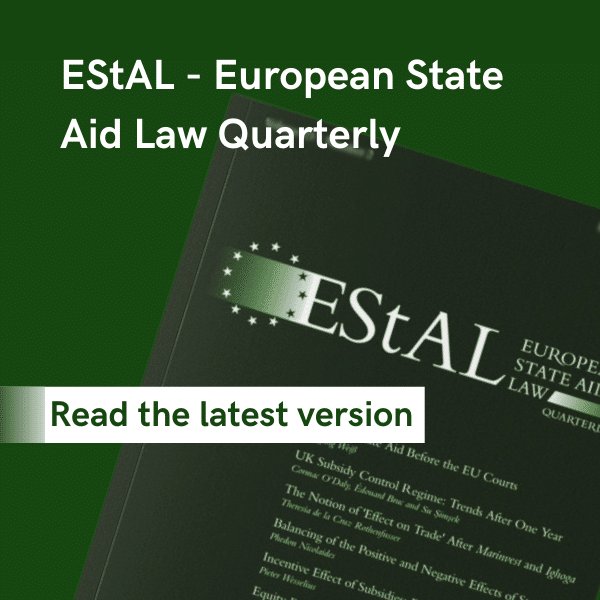
Tax rulings on transfer pricing have to approximate market-based outcomes.
Introduction
Twenty years ago, the European Commission initiated discussion on how State aid rules could apply to direct taxation. In 1998 it adopted its Notice on direct business taxation. At about the same time the Commission launched several formal investigations which culminated in negative decisions.
In 2013 and 2014, the Commission reignited its interest in direct tax measures. It sought information from Member States and opened investigations in tax rulings by Ireland (Apple), Luxembourg (Fiat, Amazon, McDonald’s), the Netherlands (Starbucks), and Belgium (Excess Profit scheme). So far, it has concluded the investigations with negative decisions on the measures concerning the Excess Profit scheme, Starbucks and Fiat.
Recently, the Commission published its Notice on the Notion of State Aid and a Working Paper by staff of DG Competition on State Aid and Tax Rulings [background to the High Level Forum on State Aid of 3 June 2016]. The decisions on the Excess Profit scheme, Fiat and Starbucks, the Notice on the Notion of State Aid and the Working Paper all refer to transfer pricing and the arm’s length principle.[1]
In essence, the Commission wants prices charged between companies belonging to the same group to approximate “market-based outcomes”. The question that arises is whether it is economically rational for intra-group transactions to resemble market-based outcomes.
The principles adopted by the Commission
The main principles which guide recent Commission investigations and decisions and which have been elaborated in the June 2016 Working Paper by DG Competition. [All cited text in this section is from the Working Paper.]
The Working Paper first re-states the fundamental tenet that State aid rules apply to all measures that satisfy the criteria of Article 107(1) TFEU and then provides a review of the Commission’s activities in the field of direct taxation.
(3) “Since 2001 the Commission has conducted a series of investigations into Member States’ fiscal schemes that appeared to benefit only certain companies. Since then, the Commission has adopted a series of negative decisions finding such schemes to selectively advantage multinational companies. These decisions have inter alia, concerned national schemes that accept multinational corporations pricing their intra-group transactions in a manner that does not reflect the conditions that apply between independent companies at arm’s length. This “arm’s length principle” aims to ensure that all economic operators are treated in the same manner when determining their taxable base for corporate income tax purposes, regardless of whether they form part of an integrated corporate group or operate as standalone companies on the market.” [Emphasis added]
(4) In 2006, the European Court of Justice endorsed the arm’s length principle for determining whether a fiscal measure prescribing a method for an integrated group company to determine its taxable profit gives rise to a selective advantage for the purposes of Article 107(1) TFEU. [Joined Cases C-182/03 and C-217/03 Belgium and Forum 187 ASBL v Commission] Accordingly, a fiscal measure that endorses a method for determining an integrated group company’s taxable profit in a manner that does not result in a reliable approximation of a market-based outcome in line with the arm’s length principle can confer a selective advantage upon its recipient. That would be the case where such a fiscal measure results in a reduced taxable profit, and thus reduced corporate income tax liability.” [Emphasis added]
“(5) The Commission does not call into question the granting of tax rulings by the tax administrations of the Member States. It recognises the importance of advance rulings as a tool to provide legal certainty to taxpayers. Provided they do not grant a selective advantage to specific economic operators, tax rulings do not raise issues under EU State aid law.”
“(6) Overall, DG Competition has looked at more than 1,000 tax rulings.”
“(7) The inquiry has focussed, in particular, on tax rulings which endorse transfer pricing arrangements proposed by the taxpayer for determining the taxable basis of an integrated group company. Transfer prices refer to the prices charged for intra-group transactions concerning the sale of goods or services between associated group companies.”
Then the Working Paper provides information on the preliminary findings of the investigations with respect to transfer pricing rulings.
“(11) The tax ruling practices of the Member States differ significantly in quantitative terms over the period investigated. Some Member States have issued thousands of rulings to economic operators every year, among which many are transfer pricing rulings. By contrast, five Member States (Bulgaria, Croatia, Latvia, Greece and Slovenia) have informed the Commission that they did not grant any transfer pricing rulings during the period under investigation.”
“(12) In terms of the procedure, most Member States follow closely the procedural guidance provided by the EU and the Organisation for Economic Co-operation and Development (OECD) for granting a transfer pricing ruling.”
The most important section of the Working Paper is entitled “Tax rulings: how to approximate market prices”. Here the Commission elaborates its views on how the pricing between groups can reflect market-based outcomes.
Do you know we also publish a journal on State aid?

The European State Aid Law Quarterly is available online and in print, and our subscribers benefit from a reduced price for our events.
“(13) A considerable number of the rulings relate to transfer pricing arrangements that appear to reflect a reliable approximation of a market based outcome in line with the arm’s length principle. In general, rulings that cover intra-group transactions between two different Member States, where both companies carry out genuine economic activities on which they are taxed, have been found to be unproblematic.”
“(14) However, some transfer pricing arrangements do not seem to reflect the arm’s length principle when the outcome manifestly deviates from a reliable approximation of a market based outcome.”
“(15) This concerns, for example, a number of tax rulings regarding the remuneration of financing companies that are part of group companies. The only activity of such financing companies is the passing-on of funds or intellectual property (IP) rights from one group company to another. In some Member States with no withholding tax, there are tax rulings approving profit margins for these financing companies.”
“(17) As regards selecting the most appropriate transfer pricing method, the OECD’s Transfer Pricing Guidelines describe five methods to approximate an arm’s length pricing of transactions between companies of the same corporate group: (i) the comparable uncontrolled price method (CUP); (ii) the cost plus method; (iii) the resale minus method; (iv) the transaction net margin method (TNMM) and (v) the transactional profit split method.”
“(18) As set out in the Commission Notice on the Notion of State aid, the OECD Guidelines “provide useful guidance to tax administrations and multinational enterprises on how to ensure that a transfer pricing methodology produces an outcome in line with market conditions. Consequently, if a transfer pricing arrangement complies with the guidance provided by the OECD Transfer Pricing Guidelines, including the guidance on the choice of the most appropriate method and leading to a reliable approximation of a market based outcome, a tax ruling endorsing that arrangement is unlikely to give rise to State aid.”
“(23) There are cases where finding a market outcome is not straightforward and requires the use of an approximation. This is not a concern as such, as long as the approximation is as precise as it can be under the circumstances. In other words, the “search for a ‘reliable approximation of a market-based outcome’ means that any deviation from the best estimate of a market-based outcome must be limited and proportionate to the uncertainty inherent in the transfer pricing method chosen or the statistical tools employed for that approximation exercise.”
A critique
It is well understood that when a company receives more favourable treatment than other similar companies, it obtains a selective advantage. Inherent in the concept of selectivity is a comparison exercise. But which companies are to be compared? A problem arises because transfer pricing rules apply only to companies that belong to a group, while normal tax rules apply to independent companies. If the normal tax rules applied to related companies, they could result in very low taxes, for the simple reason that intra-group transactions can be priced just above costs, generating little profit. Related companies are subject to taxation, but they are not subject to the same market pressure to maximise profits by charging as high price as possible.
The purpose of tax rulings is indeed to force related companies to pay tax. Hence, the comparison should be between related companies in one group with related companies in another group. The tax treatment of related companies across the board should be uniform.
However, the Commission does not espouse this approach. Instead of comparing the treatment of companies, it compares the treatment of transactions. It wants intra-group transactions to be compared against a hypothetical or artificially constructed benchmark of transactions between independent companies. According to the Commission’s approach, in order to determine whether transfer pricing rules result in a selective advantage, it is necessary to compare their effect on companies to which they apply and the effect of the normal tax rules which apply to other companies. In other words, the impact of the normal tax rules is approximated as if they applied to companies that belong to a group.
Prices between related companies can be decided on the basis of reasons other than profit such as, for example, the minimisation of tax liability. A company that belongs to a group can reduce its tax liability by charging to related companies lower prices than otherwise. Its profit will be artificially smaller and the amount of tax it has to pay, which is calculated as a percentage of profits, will be commensurately lower.
In addition, groups of companies may want to set up subsidiaries for the explicit purpose of avoiding purchases on the open market. This happens when the subsidiary can produce or procure the product or service in question at lower cost or lower price. It may, therefore, rather justifiably charge lower prices to related companies which buy from it. In addition, transactions between companies are likely to be subject to less uncertainty and risk because a parent company, for example, should normally be fully aware of the capability and reliability of its subsidiary companies. The lower risk and the more effective control that can be exercised over related companies should, ceteris paribus, result in lower prices than normal market prices for similar products, which are decided at arm’s length.
For example, it is rather instructive that on 26 May 2016, in case T-479/11, France v Commission, the General Court annulled a Commission decision that failed to account properly for the effect of an unlimited state guarantee granted to Institut Français du Pétrole [IFP]. The Commission claimed that the guarantee affected the pricing of goods and services between the IFP and its suppliers and clients, respectively. Although the General Court faulted the Commission for not proving who the actual beneficiary of the state guarantee was, the General Court did accept that in principle a state guarantee reduced the riskiness of the IFP and therefore could have an impact on the prices transacted between IFP and third parties [paragraphs 90-128]. By analogy, control of one company over another reduces the risk which is inherent in the transactions between different companies.
Given the fact that transactions between related companies are subject to a higher degree of transparency and lower risk, it is difficult to compare them to transactions between independent companies.
The OECD Transfer Pricing Guidelines for Multinational Enterprises and Tax Administrations 2010, (hereafter “OECD Guidelines”), recognise that the so called “integration behaviour” – the behaviour of companies belonging to the same group – hamper the effective application of the arm’s length principle in assessing pricing of transactions between related companies. In particular, the OECD Guidelines note “a practical difficulty in applying the arm’s length principle is that associated enterprises may engage in transactions that independent enterprises would not undertake. Such transactions may not necessarily be motivated by tax avoidance but may occur because in transacting business with each other, members of a [multinational enterprise] group face different commercial circumstances than would independent companies.” [pp. 34-35] This is a consequence of the “different commercial circumstances” which integrated companies, on the one hand, and independent companies, on the other, face in carrying out their business activities.
The above has also been acknowledged in the tax literature (See B.E. Lebowitz, “Transfer Pricing and the End of International Taxation”, 9 Tax Notes International 13 (27 September 1999), 1202, where the author notes that: “[…] related entities are economically different creatures than unrelated ones. While this notion is probably intuitive to business people, economists in the field of industrial organization have recently developed an entire subfield devoted to analyzing the variety of economic relationships that exist among, as well as within, economic entities and the circumstances under which transacting within or outside a single entity (or commonly controlled group of entities) is economically more advantageous”.
Related companies may structure their affairs and enter into transactions that differ from those between unrelated companies. In this case the arm’s length principle is difficult to apply because of the lack of comparable transactions. This phenomenon has been pointed out in the tax literature as well (see R.S. Avi-Yonah, “The Structure of International Taxation: A Proposal for Simplification”, 9 BNA TMTPR 3 (1 November 2000) at page 19: “If MNEs exist because of market imperfections in the arm’s length market, the implication is that comparable transactions will not be found when an MNE is successful because the MNE will have driven the arm’s length competitors out of business. Presumably an MNE that could have operated at arm’s length through a local entity would have done so because of the normal difficulties of operating in a foreign country with a different culture and legal system. If an MNE chooses to integrate and still remains profitable, this suggests that there are disadvantages to operating through the market – disadvantages that would make finding arm’s length comparables a difficult task”.
The quoted excerpts from the Commission’s Working Paper, which mirror the views expressed in the Commission’s Notion of State Aid, provide no explanation of what can be a “market-based outcome” when a company belongs to a group. They also offer no explanation why there should be approximation with market-based outcomes. Lastly, there is no indication how the arm’s length principle may be applied. Perhaps no further information is given because it is assumed that Member States will follow the OECD approach. However, since not all Member States follow the OECD procedural guidance, the Commission should have been more explicit on what it considers to be the right approach and should not have limited itself to merely stating that “provided they do not grant a selective advantage to specific economic operators, tax rulings do not raise issues under EU State aid law”. This statement is more of a tautology than an explanation because it offers no guidance when a tax ruling does not grant a selective advantage.
More importantly and as the General Court observed in its judgment in case T-479/11, France v Commission, the claimed deviation of prices charged between the IFP and third parties from normal market prices had to be proven. By analogy, the alleged deviation of transfer pricing from “market-based outcomes” has to be proven too.
——————————————————–
[1] DG Competition has a web page dedicated to tax rulings. It contains all the documents mentioned above and the opening and final decisions on tax measures. It can be accessed at:
http://ec.europa.eu/competition/state_aid/tax_rulings/index_en.html.
* Only e-book, no hard copy.



